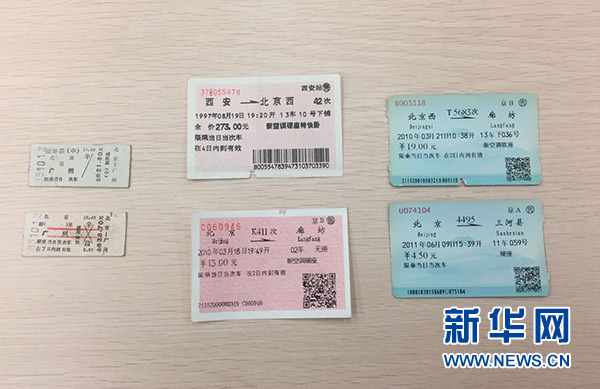Evolving train tickets reflect rapid changes to China's railway services
In recent years, paperless travel services have gradually prevailed across China. The change in the form of train tickets from hardboard to e-tickets has mirrored the continuous upgrading of China's railway services, and symbolizes increasingly convenient travel in the country.

Photo shows train tickets made of hardboard. (Photo/Renmin Tiedao)
The first train tickets in China were made of hardboard. They were less than 6 centimeters long and 2.5 centimeters wide. Since ticket sellers needed to add passenger information to the tickets manually and calculate the prices of the tickets using the abacus, a passenger had to wait 5 to 10 minutes before getting a ticket.
Hardboard train tickets were a version of Chinese train tickets that have been used the longest. They weren’t replaced by paper tickets until the 1990s.
In the wee hours of Sept. 15, 1959, train ticket seller Jia Genzhu handed a hardboard ticket to the late Chinese leader Mao Zedong during his inspection of the Beijing Railway Station, which was the first time Mao had seen the first-generation train tickets of the People's Republic of China.

Late Chinese leader Mao Zedong watches a first-generation train ticket of the People's Republic of China. (Photo/China Railway Beijing Group Co., Ltd.)
In 1997, China's second-generation train tickets, computer-printed soft red paper tickets, were launched. At that time, ticket sellers would input the date and train number into a computer, and then print the ticket. The whole process could be finished in a minute.
In 2007, the country started to promote blue train tickets that recorded information using the magnetic medium. The tickets could be used to pass through self-service ticket checking machines.
Since June 2011, passengers have been able to pass through checkpoints in railway stations of the country by having their ID cards scanned at self-service machines.

(Photo/Ding Bo)
The continuous upgrading of train tickets and increasingly improving the travel experience across China have been attributed to the country's booming railway industry.
As of the end of 2022, the total length of China's operating railways exceeded 155,000 kilometers, and the operating length of the country's high-speed railways in service accounted for more than two-thirds of the world's total. Meanwhile, the average daily number of passenger trains running on the country's railways surpassed 10,000 during peak periods.

Photo shows train tickets of different times. (Photo/Xinhua)
Photos
Related Stories
- 'Study trains' provide haven for passengers of all ages
- An insider's view on historic changes in train ticketing system
- In numbers: Tibet to complete the building of 4,000 km of railway lines by 2025
- China-Laos-Thailand round-trip freight train launched from China's Yunnan
- Affectionate hugs warm return trips after Lantern Festival
- All railway construction projects resume in China's Yangtze River Delta
- China logs over 1 mln railway trips after Spring Festival
- Slow train provides study room for student passengers in SW China's Chongqing
- Beijing-Zhangjiakou high-speed railway line brings convenience to people's skiing trips
- Pic story: female railway police officer unit in Chongqing, SW China
Copyright © 2023 People's Daily Online. All Rights Reserved.









